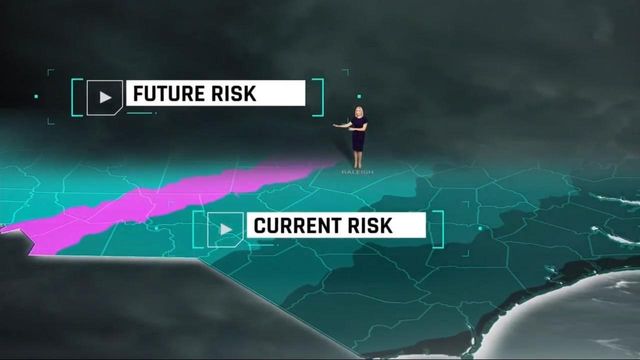Climate change is moving hurricane risks farther inland
As hurricane season approaches, researchers warn the risk of flooding and severe weather are moving farther inland.
Posted — UpdatedThe Atlantic hurricane season starts on June 1, but you don't have to be on the coast to be in the path of dangerous winds and flooding.
Researchers say climate change and rapid development are moving danger zones farther inland, putting more people in harm's way.
This is troubling news for the many North Carolinians still reeling from the impact from Hurricane Florence in 2018. That storm dropped over three feet of rain – the state's wettest hurricane.
"We still have more than 150 cases that need our help and many are still in need of a place to live all these years later," said Kay Coole of the Carteret Long Term Recovery Alliance. She says recovery could take as long as a decade, with communities at risk to get hit again with catastrophic extreme weather.
Tropical systems producing more rain
The behavior of tropical systems is changing due to climate change. Now they are producing more rain, moving slower, and lasting longer over land.
As temperatures rise, warmer air molecules carry around more water vapor, causing more potential rainfall and increasing the chance of inland flooding.
The North and South poles are also getting warmer, and the pressure differences between the poles and tropical systems is now smaller, slowing down the steering currents that push these tropical systems along.
A recent study shows that tropical systems have slowed down by 10% in the past 75 years.
Another study shows that tropical systems are lasting longer over land. Fifty years ago, a typical tropical system would have lost more than three-quarters of its intensity in the first 24 hours of landfall. Now, it would only lose half.
Those changes are putting more North Carolinians at risk, with strong winds fueled by climate change are moving farther inland and northward.
The annual chance of hurricane-force winds is increasing, with risk areas expected to continue expanding west of Raleigh.
New flood risk calculations from researchers are much higher than government estimates, with nearly twice as many properties now in the floodplain.
Thirty-one counties in the state are projected to see more than a 20% increase in flood risk in the coming decades, including Washington County, where floods could be 609% more likely by 2050 than they are now.
“Communities across the state are working to reduce their flood risk through buyouts, elevating homes and upgrading infrastructure, but it’s harder to see those benefits when we’re adding more houses and people to floodplains at the same time,” Hino said.
Rapid development is also changing the way water moves in severe weather, further influencing the floodplain.
"The land use changing makes it harder for us to collectively understand where the risks are and where the hazards are," Hino said.
Hino says zoning decisions play a critical role in flood risk management. Some communities rewarded by FEMA for mitigation efforts were the same communities allowing new housing development in the floodplain.
"We're putting more people and properties in harm's way," said Hino.
Now, home buyers in North Carolina will have access to a property’s flooding history, a disclosure that was not required of sellers until a change from the North Carolina Real Estate Commission earlier this year.
“Strategic planning and zoning can encourage growth in safer areas and prepare us for the inevitable heavier downpours and wetter hurricanes which can cause more damage in the long term,” Hino said.
Related Topics
• Credits
Copyright 2024 by Capitol Broadcasting Company. All rights reserved. This material may not be published, broadcast, rewritten or redistributed.






